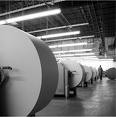I came across this report yesterday on PrintWeek.com highlighting the fact that major paper manufacturers have continued to announce price increases during the first two months of 2010 due to general increases in energy, freight and the cost of raw pulp rising almost a third in the past twelve months. Combine this with a paper market suffering from reduced demand and overcapacity and you end up with the economic inevitability of a rise in print costs.
The US and European print industries continue to face stiff competition from low-cost printers in the Far East and in an effort to sustain business they have tried to absorb rising and fluctuating costs even though their own print customers are still in a fixed mindset of cost reductions. The publishing industry is fighting its own battles with production and marketing costs, bookseller discounts, and a changing industry grappling clumsily with digitization. While e-books remain in their infancy and represent a tiny fraction of the book sales market, the greater and longer term decline of the paper manufacturing and print industries may not just be consumers moving online to source news and information. The decline may also be accelerated by the arrival of multi-use download devices like the Apple iPad and its cousin, the iPhone.
So what does a potential rise in print costs mean for self-publishing authors and publishers?
At the moment, the brunt of any on-coming storm will clearly be felt by publishers directly. Their bread and butter remain for the foreseeable future in the sale of paper books using lithographic print runs. I just don’t see a wholesale switch to digital print on demand so long as book sales are driven by brick and mortar stores. The economics, viability and green ethos of print on demand won’t stand up to the echoing footfalls of the browsing book consumer. Print on demand just doesn’t do inventory and shelf to shelf displays. I can see a legitimate and worthy use for the Espresso Book Machine in every bookstore. Imagine a bookstore where the shelves are only filled with say the top 50 or 100 titles and everything else is browsed through using online terminals in the bookstore. You make your way to the sales counter while your choice of book is sent to the print job queue of the EBM. In theory, you could also do this from home and then collect or have your book sent to you by mail. The speed of the current EBM would still have to be dramatically improved, certainly to a minute or under.
At the moment, this kind of development for consumer, bookseller and publisher is more of a stop-gap or half-way-house to the day when e-books hold upwards of a 50% market stake. Ultimately, bookstores will have to become more than a physical place to sell books. Whether that means bookstores merging with libraries and internet cafes and diversifying into other comparable products, all remains to be seen. We might also consider the potential explosion in second-hand bookstores if the e-book sales grown even quicker than expected. Paper and print products may sadly become very expensive and occasional gift products.
For self-publishing authors, the dilemmas are a little more straight forward—print or e-book, or both? Go it alone or use an author solutions service? Right now, I don’t think I have ever experienced a time when POD publishing service prices are falling as they are now. More authors are moving towards services like Lulu and CreateSpace, or going directly to Lightning Source. This is leading to the powerhouses of solutions services owned by ASI (AuthorHouse, Xlibris, Trafford and iUniverse), as well as Xulon to engage in heavy discounting on their publishing packages over the past two or three months, mainly on their mid and top-end packages. It just goes to show you how much ‘leeway’ and profit was built into those expensive packages, combined with the fact that authors are becoming far more savvy about self-publishing and what a good deal really is.
March has been a traditional month when publishing services review and often increase their prices. The current discount trend doesn’t suggest we are going to see that this year, certainly not in the first half of the year. In light of our initial foray into the rising costs in paper manufacturing and the print industry, I would suggest self-publishing authors keep their eyes firmly peeled on the cost of books sold to them by their solutions service. Many of them use Lightning Source, and, as of yet, to their credit, the printer and fulfilment solutions giant has held firm on prices. Whatever pressures—if any—they may be experiencing, they have chosen to absorb rather than pass them on. This from their UK site:
Pricing
Consider this example of a 200-pg. paperback submitted digitally:
|
£12.99
|
Publisher sets Retail Price
|
||
|
35
|
%
|
Publisher sets Retail Discount
|
|
|
£8.44
|
Wholesale Price
|
||
|
£2.70
|
Less Print Cost
|
||
|
|
|||
|
£5.74
|
Publisher earnings for each book sold
|
||
I often repeat the general example of the figures above ($3.90 in USA for print cost) because some author solutions services like to build and conceal hidden profit margins into the print figure. Be wary of services who claim their print costs for a 200 page book (approx) are much more than the above example, and be even more wary if they will not disclose what the cost is at all.
For now, in the print and author solutions world, it’s as you were, but keep those eyes on the bottom dollar.
.

